Are you a marketer or bulk email sender? Campaign Monitor might be too costly for you. Fortunately, there are a lot of free and paid alternatives you can choose from.
Digital marketing agencies love Campaign Monitor for a range of unique features, like private labeling, granular user permissions, and others. For a small business, these advantages don’t add any value –— so what are your other options?
Nevertheless, there are reasons why email marketers choose Campaign Monitor. Let’s start with taking a look at the best features of the product and then see how it compares to Campaign Monitor alternatives.
Table of contents
Why email marketers choose Campaign Monitor
Campaign Monitor is a straightforward email marketing solution with a user-friendly interface and simple features. Users always highlight the following pros of the tool:
- A rich collection of mobile-responsive email templates
- Agency-focused features, including a client dashboard, multi-user access, private labeling, granular user permissions, special agency discounts, etc.
- Easy-to-use drag and drop builder for emails
- Countdown timer (available for higher plans)
- Granular view of audience segments and individual contacts
- Automated journeys are available inside all plans
- Robust API for custom integrations
- Good email deliverability
- Real-time campaign insights
- Transactional emails
Drawbacks of using Campaign Monitor
And why is it worth considering Campaign Monitor alternatives?
- It’s difficult to customize templates — you can’t access the HTML email editor if you choose pre-built templates
- There’s no free plan inside Campaign Monitor (apart from the 30-day free trial)
- Users need to pay more as their contact list grows
- Campaign Monitor offers limited multichannel and CRM functionality compared to some competitors
Campaign Monitor pricing
How much does Campaign Monitor cost?
Campaign Monitor offers a 30-day free trial that includes up to 500 contacts and 500 email seends.
The Lite plan starts at $12/month. The package includes 500 contacts and 2,500 emails/month. For additional 2,000 contacts and 10,000 emails within the same plan, you’ll pay around $44/month.
Interestingly, there’s no significant gap in the functionality of the Lite, Essentials, and Premier plans. Users can set up automated workflows, run A/B tests, segment contacts, and send transactional emails in all plans.
7 top Campaign Monitor alternatives
Disclaimer: This article covers the best Campaign Monitor alternatives — including our platform, Brevo. Our recommendations are based on use case, market share, and customer testimonials. No commissions are made from affiliate links in this article.
The information below was last updated on September 19, 2025.
Looking for a cheaper alternative to Campaign Monitor? These are the best ones to choose from.
1. Brevo

Need a tool with multichannel marketing functionality? Brevo stands out as a marketing automation platform for email marketing service, transactional email sending, CRM software, and SMS marketing.
Brevo or Campaign Monitor?
Here’s why Brevo is one of the best alternatives to Campaign Monitor.
- Free plans: Not sure you’re ready to invest in a paid plan? You can use Brevo for free forever. Send up to 300 emails/day without paying a cent.
- Pricing packages: Brevo’s paid plans start at $9/month for 500 contact credits and up to 5,000 emails per month. To send that many emails with Campaign Monitor, you’ll need to pay around $44/month.
- Multichannel marketing: Apart from SMS, Campaign Monitor offers limited functionality for multichannel marketing. Meanwhile, Brevo lets you combine email, SMS, and chat communication effortlessly.
- CRM: Brevo's has a fully integrated CRM to track customer engagement, interactions, and much more.
- Sales Platform: Brevo also offer a Sales Platform. Track and manage sales pipelines, set up meetings with prospects directly and keep your team on the same page all from one place.
- Transactional emails: Finally, both platforms allow you to send transactional emails with high deliverability rates. While many email marketing platforms include transactional email sending in more expensive plans, Brevo SMTP and Email API are available for both free and paid users.

"Reliable, Affordable, and Surprisingly Powerful All-in-One Marketing Platform"
"Brevo has a great balance between ease of use and robust features. The email builder is intuitive, automations are easy to set up, and the contact segmentation tools are flexible enough for both simple and advanced campaigns. Brevo’s support team has been prompt and genuinely helpful. It’s a relief knowing we won’t be stuck mid-campaign. Considering its pricing, Brevo packs a lot in: drag-and-drop email builder, automations, segmentation, SMS, chat, and a built-in CRM. We use Brevo daily, and it’s fast become the backbone of our email workflows. From campaign setup to performance tracking, it’s consistently part of our routine. Connecting Brevo to our existing tools has been a breeze. That seamless data flow makes campaign setup and audience syncing effortless."
Elias R.,
Product Marketing Coordinator
"Easy-to-use interface, and quick, friendly support."
"The web interface is good, and it's very clear how to get started with things. I needed to have the SMS service activated by Customer Support, and this request and the follow-up queries were handled in a very timely and refreshingly affable manner."
George Edwards,
Brevo user
2. ActiveCampaign
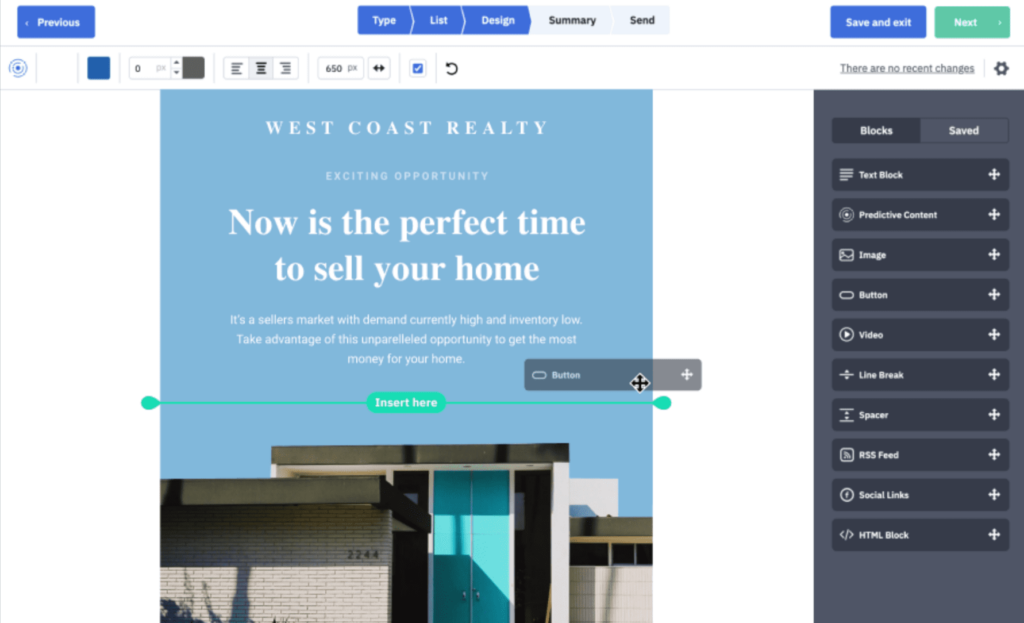
ActiveCampaign is probably the closest Campaign Monitor competitor. If you look at the pricing models, the platforms are almost identical but for a few critical features.
ActiveCampaign or Campaign Monitor?
- Pricing packages: ActiveCampaign starts at $15/month for up to 1,000 contacts.
- Free access: Neither platform offers a free plan.
- Lead scoring: As with the Brevo software, ActiveCampaign allows for automated lead scoring. You won’t find this feature inside Campaign Monitor.
- Site tracking: If you want to connect your email marketing software to your website activity, it's probably better to choose ActiveCampaign.
- A/B testing: For users who wish to test automations in their email newsletters, ActiveCampaign might be too pricey — A/B testing for automations isn’t included in lower tiers. Campaign Monitor offers A/B testing for email elements as a part of all plans (but complex automation testing is limited).
- Mobile app: ActiveCampaign is one of the few brands offering a mobile app for managing email campaigns and contacts on the fly.
- SMS marketing: ActiveCampaign is good for email marketers looking for SMS marketing and other multichannel marketing features.
- CRM: ActiveCampaign offers tools for CRM and sales automation, and Campaign Monitor doesn’t.
Further reading:
3. Moosend
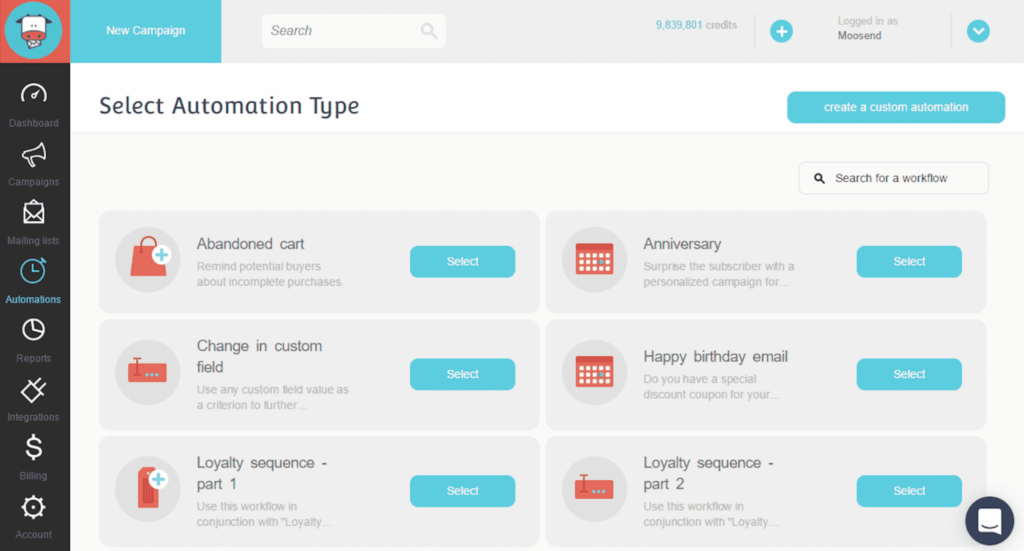
Moosend is an email marketing platform with a couple of exclusive features. It’s particularly good for SMBs and email marketing beginners.
Moosend or Campaign Monitor?
- Pricing packages: For $9/month, you can add up to 500 contacts to your Moosend account. In contrast to Campaign Monitor, the cheapest Moosend plan comes with unlimited email sending.
- Free access: Moosend doesn’t have a free plan but provides a 30-day free trial.
- Landing pages: With Moosend, you can create responsive landing pages starting at $9/month.
- Shoppable emails: Moosend displays buyable products within emails and helps to craft catchy email annotations for Gmail Promotions Tab.
- Ecommerce product recommendations: Moosend offers personalized product recommendations as a part of their ecommerce toolkit. The product lets you set triggers for cross-selling emails and refill notifications.
- Subject line tester: The tool can estimate your email open rates based on your subject lines.
- Countdown timers: While Campaign Monitor includes countdown timers only in top-tier plans, Moosend makes the feature available for all users.
4. HubSpot
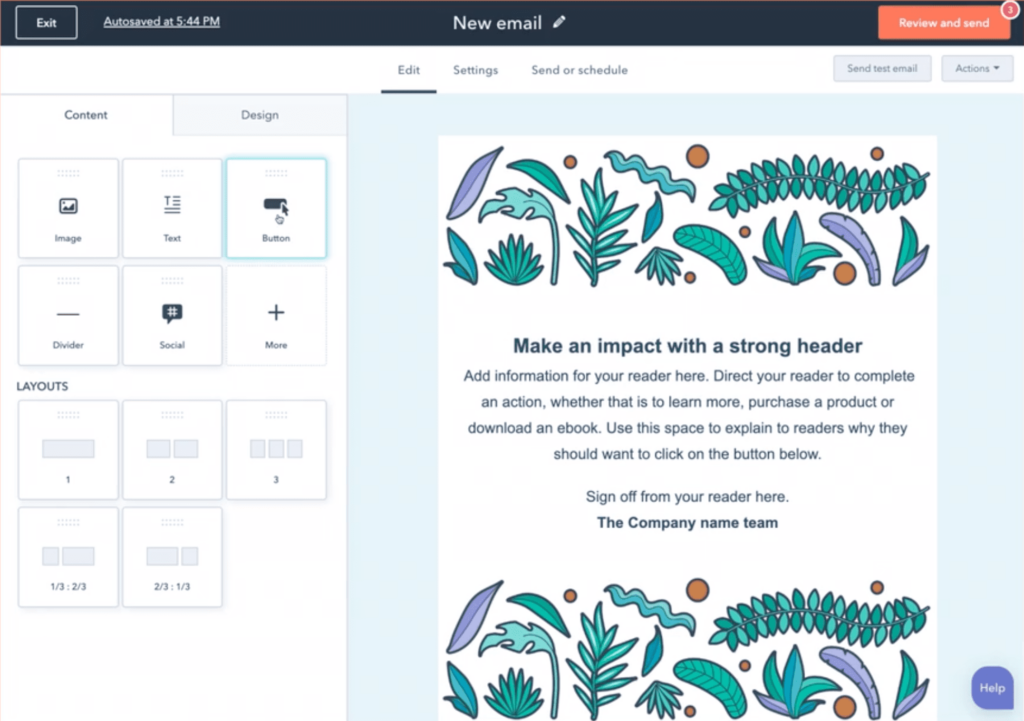
HubSpot is a great alternative to Campaign Monitor if you use its free plan, which includes up to two users. However, pricing can quickly go up if you need to access more advanced tools.
HubSpot or Campaign Monitor?
- Free access: HubSpot offers a nice collection of free tools, including a drag and drop email builder, basic CRM functionality, list segmentation, landing pages, and live chat.
- Pricing packages: HubSpot’s paid plans start at $15/month/seat. This is includes 1,000 contacts and HubSpot's free marketing tools. However, prices rise quickly as your contact list grows.
- Marketing automation tools: HubSpot users don’t have access to automation features inside free plans. To use automated workflows, it’s better to choose Campaign Monitor.
- Mobile app: All HubSpot users can access a mobile app and accomplish all the tasks they would typically do with the desktop version.
- A/B testing: Advanced features, like A/B testing, are only available starting from HubSpot’s Professional plan ($890/month).
- Customer support: HubSpot is famous for its world-class customer support team.
Further reading:
5. Omnisend
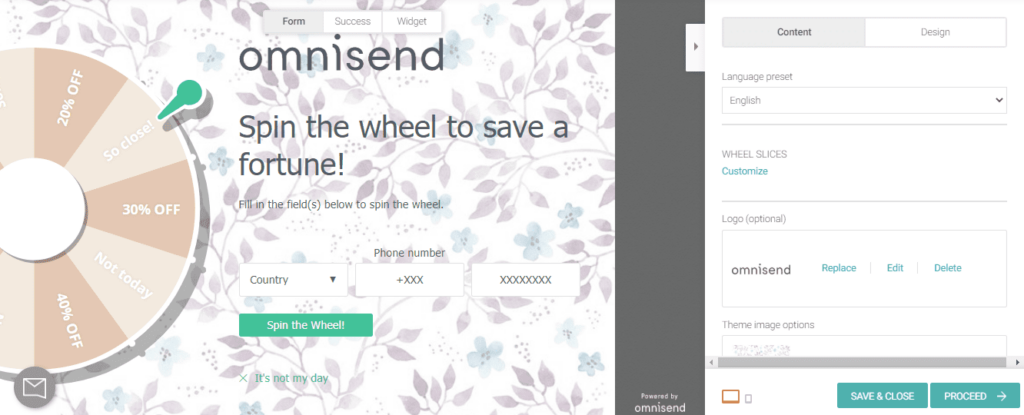
Omnisend is an email and SMS marketing platform with a focus on ecommerce automation.
Omnisend or Campaign Monitor?
- Free access: Omnisend includes up to 250 contacts and 500 emails/month in a forever-free plan.
- Pricing packages: The cheapest paid plan costs $16/month and includes up to 500 contacts, 6,000 emails, and max. 60 SMS notifications per month. You can also add extra credits to the most basic plan or upgrade to the higher tier package ($59/month) for additional features.
- Email automation software: Omnisend users can create both pre-built and custom automated email workflows.
- Ecommerce platform: Ecommerce-specific features, like personalized recommendations, pre-built ecommerce workflows, dynamic content, and auto-generated discount codes are available inside Omnisend.
- Exclusive features: Omnisend offers a range of exclusive features to increase conversions of your signup forms, pop-ups, and email content. Users can add Wheel of Fortune, scratch cards, interactive Gift Box, and other elements to gamify their campaigns.
- Landing pages: There’s a built-in landing page building tool for your lead generation campaigns.
- SMS marketing: SMS sending is also a part of Omnisend’s features in all plans.
Further reading:
6. AWeber
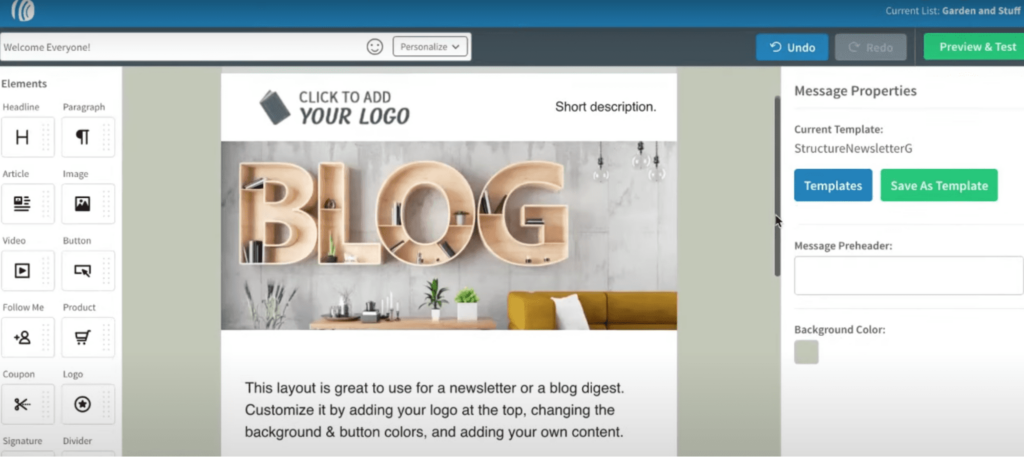
AWeber is an email marketing tool for small ecommerce brands. It’s good for setting up simple and inexpensive campaigns.
Aweber or Campaign Monitor?
- Free access: If you don’t exceed the limit of 500 contacts, you can use Aweber for free.
- Pricing packages: Aweber starts at $15/month. When it comes to monthly email sends AWeber lets you send 10x your contacts (compared to 5x subscribers on Campaign Monitor's Lite plan).
- Transaction fee: Mind that AWeber charges a 2.9%+$0.3 fee (+1,0% or 0.6% depending on the plan) per transaction if you run sales campaigns.
- Multi-user access: AWeber includes up to 3 users on the Lite plan and unlimited users on its Plus plan. On the other hand, Campaign Monitor offers unlimited number of users in all paid plans.
- Ecommerce: AWeber users can set up recurring payments, send autoresponders, and track sales.
- Landing pages: A drag and drop editor for landing pages is included in free and paid Aweber plans.
Further reading:
7. Constant Contact
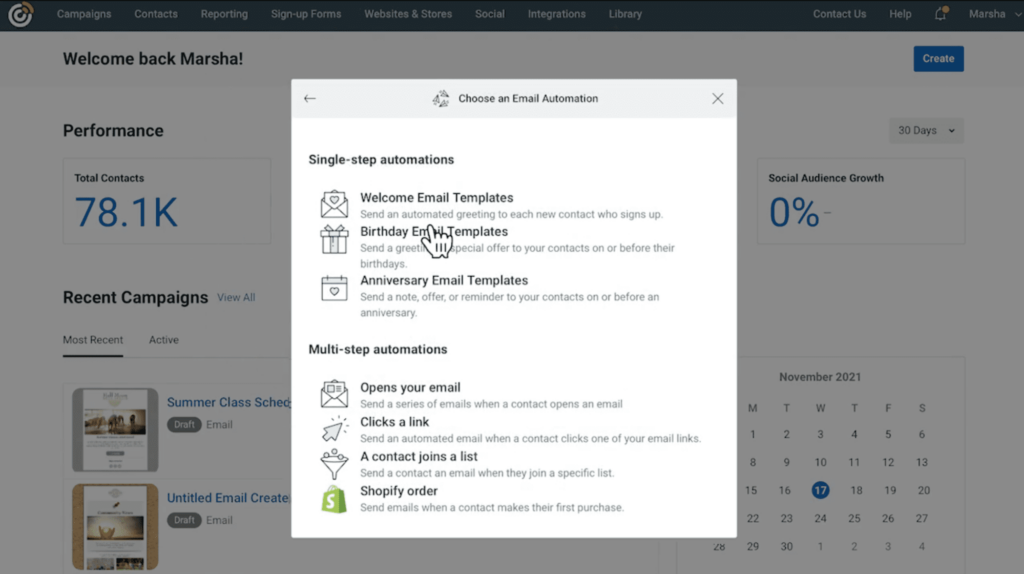
Finally, meet Constant Contact. The platform provides all the necessary tools for generating leads, nurturing them, and collecting their feedback.
Constant Contact or Campaign Monitor?
- Free access: Constant Contact does not offer a free plan. Like Campaign Monitor, they offer a 30-day free trial.
- Pricing packages: Constant Contact’s Lite plan begins at $12/month. For mid-sized businesses and enterprises, Constant Contact offers a Standard plan starting at $35/month for 500 contacts.
- Mobile app: It’s possible to manage campaigns through Constant Contact’s mobile app.
- Collect feedback: Constant Contact allows users to collect feedback through embedded polls and surveys.
- Multichannel marketing: Users can post to social media platforms and design Facebook and Instagram ads directly inside the Constant Contact interface.
Further reading:
Which Campaign Monitor alternative is right for you?
These are the closest Campaign Monitor competitors. To choose the right tool, spend some time taking advantage of free plans and free trials.
A lot of options get more expensive as you grow. Think of how your email marketing strategy will look in six months or a year and pick a Campaign Monitor alternative that supports your business growth.
In sum: Choosing a Campaign Monitor alternative
When considering Campaign Monitor alternatives, here are a few pointers:
- For all-in-one email marketing and CRM features: Brevo stands out as a strong contender, with multichannel marketing capabilities and a built-in CRM.
- For marketing agencies: Look at ActiveCampaign and Constant Contact. ActiveCampaign offers advanced automation for complex campaigns, while Constant Contact provides a comprehensive suite of marketing tools beyond email.
- For email marketing beginners: Consider Moosend and Brevo. They offer great value with high email sending volumes on their paid plans. Brevo also offers generous contact storage and email sends across the board.
- For ecommerce: Omnisend is a specialized alternative with features like shoppable emails and gamified forms. ActiveCampaign is another strong contender due to its powerful automation features.
- For startups and creators: AWeber is known for its ease of use and features that cater to content creators and small businesses.
- For enterprise: HubSpot is the best choice if you need to integrate your email marketing with a CRM and other tools like sales and service hubs.







